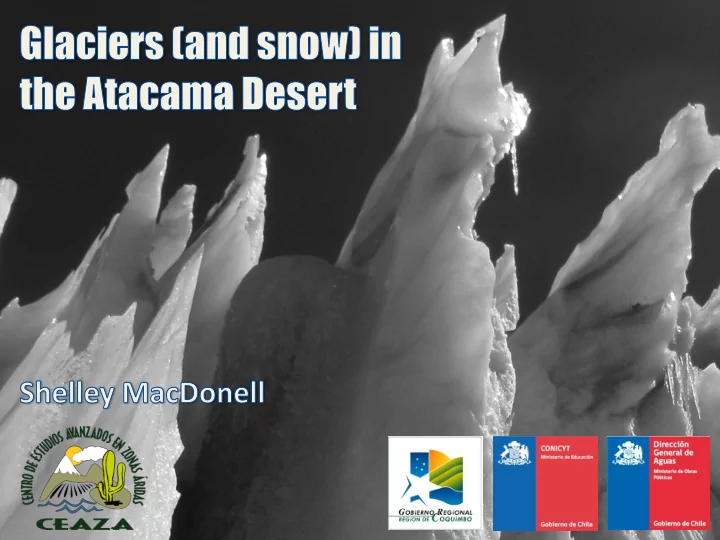

CECS-DGA: National Glacier Strategy
Driving research questions: What is the contribution of the cryosphere to the catchment? How might this change in future?
• Dry: ~200 mm/y • Episodic events of precipitation • 90 % of precipitation: May - August • The snow cover disappear during the summer period
• Dry: ~200 mm/y • Episodic precipitation events • 90 % of precipitation: May - August • The snow cover disappear during the summer period
• Dry: ~200 mm/y • Episodic precipitation events • 90 % of precipitation: May - August • The snow cover disappears during the spring - summer period
• Sublimation is the dominant ablation process on glaciers • Snow depth can disappear during winter only due to sublimation.
• Precipitation: • Temporal variability: dry and wet years (ENSO events)
• Wind: • Strong wind speed • Importance of sublimation of blowing snow Paso Agua Negra - 4774m
Snow processes How is precipitation distributed across the catchment? What is the sublimation to melt ratio? What is the hydrological contribution? Can we reduce the sublimation rate? Marion Réveillet, Simon Gascoin, Christophe Kinnard, Stef Lhermitte, Nicole Schaffer, Annelies Voordendag, Álvaro Ayala
Puclaro Dam La Laguna Dam Tapado Glacier La Laguna 3100 - 5800 m Paso Agua Negra
SnowModel (Liston and Elder 2006) Met. marion.reveillet@ceaza.cl Forcing AWS network MicroMet SnowTran-3D Creates distributed 3D model that simulates atmospheric fields based on snow depth evolution spatial interpolations (deposition and erosion) EnBal SnowPack Describes snowpack WRF output (3 km) changes in response to Performs standard surface precipitation and melt fluxes energy balance calculations defined by MicroMet and Snow depth EnBal evolution
Réveillet et al., (2018, in prep.)
Overall sublimation %: AWS WRF Rates per elevation band: 2014: 39 81 2015: 31 86 2014 2015 Sublimation (%) Ablation rate
Next steps: Improve WRF quality (help welcome) Extend timespan Hydrological importance and connection to glaciers
alvaro.ayala@ceaza.cl SWE maps (Cortés and Geodetic Margulis, 2017; Cornwell et al., mass balances 2016; Marti et al., 2017) Model Model validation validation Input data: Input data: Snow accumulation over Meteo data WRF outputs glacierized areas (from Task 2: Task 1: SnowModel) E&MB SnowModel model Forcing Forcing inputs inputs Snow Snow E&MB processes Model model Additional input data: Tapado Elqui River Lidar DEMs Glacier catchment Manual mass balances G1: Identify the controls on the G2: Identify the controls on the formation, evolution and runoff glacier mass balance and runoff contribution of the snowpack at key generation of Tapado Glacier sites in the Elqui River catchment Comparison
Glacier processes What is the sublimation to melt ratio? What is the role of penitentes in the energy and mass balance? What is the hydrological contribution? Álvaro Ayala, James McPhee, Francesca Pellicciotti, Marion Réveillet, Christophe Kinnard
Glacier mass and energy balance modelling Guanaco Glacier Toro 1 Glacier What is the effect of penitentes on the turbulent heat fluxes? Eddy covariance measurements What is the difference in ablation rate and fraction between sites? Energy/mass balance modelling
Energy flux density (W m -2 ) Surface change (mea) = -1500 mm (mod) = -1450 mm RMSE = 4.1 mm Guanaco MacDonell et al. (2013) Time (month) Energy flux density (W m -2 ) Surface change (mea) = - 3728 mm (mod) = - 3511 mm RMSE = 25.9 mm Time (month) Toro 1
Mass balance results Guanaco Toro 1 Time (month) Time (month) Total melt = 271 mm w.e. Total melt = 613 mm w.e. Total sublimation = 1164 mm w.e. Total sublimation = 2882 mm w.e. Melt % of total ablation = 19% Melt % of total ablation = 18% MacDonell et al. (2013)
In subsequent studies: • Chemistry to analyse whether permanent features + sublimation rate • Kinect to analyse ablation spatially (and validate ablation frames) And now: What is the accumulation in a penitente field?
alvaro.ayala@ceaza.cl How do ablation processes change with latitude and altitude? a) November Percentage of total ablation [%] Total ablation [mm we d -1 ] b) December c) January JN3127 JN3305 SF3466 BE4134 YE4428 TA4775 GU5324 Ayala et al. (2017)
a) Early ablation season 100 100 Percentage of total Sublimation Melt Total ablation 80 ablation [%] Evaporation 60 40 20 0 0 3000 3500 4000 4500 5000 5500 6000 Elevation [m asl] b) Late ablation season 100 100 Percentage of total Melt Total ablation 80 80 ablation [%] Sublimation 60 60 Evaporation 40 40 20 20 0 0 3000 3500 4000 4500 5000 5500 6000 Elevation [m asl]
Tapado catchment – Hydrological Implications Daily discharge totals Q snow 2013/14 Q ice 2013/14 Daily discharge (m 3 s -1 ) Q snow 2014/15 Rain Annual contribution (%) Snow melt Ice melt Q ice 2014/15 Month 2013/14 2014/15
Rock glacier processes What is the distribution of active and inactive rock glaciers? How have they changed through time? What is the amount of ice stored? What is their hydrological role? Nicole Schaffer, Francesca Pellicciotti, James McPhee, Ben Robson, Camilo Guzmán, Eduardo Yáñez, Iván Fuentes, Benjamín Castro
Schaffer et al., (2018, in review)
nicole.schaffer@ceaza.cl Rock glacier field programme re-started 2018: • How much ice? • Is there a difference between different rock glacier types (or expressions)? • Where is it? • Has it been changing? And in response to what?
+ Geophysics + Geodetic mass balance + Hydro-glacio modelling
Points for discussion • Should we explicitly include rock glaciers in catchment models? How? • Do we need to treat active and inactive rock glaciers differently? • Does a rock glacier lose mass, or just channel water generated at the surface? • How should we consider contributions to / interactions with groundwater? • What’s happening on the other side of the border?
Recommend
More recommend